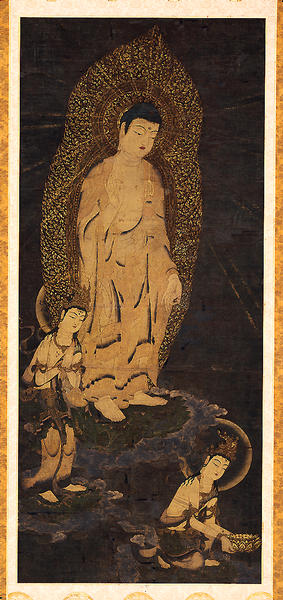阿弥陀三尊来迎図
- 南北朝時代
- 14c
- 絹本著色
- H-112.7 W-49
- 所蔵
- 赤星家旧蔵
南北朝時代 14世紀
絹本著色
縦:112.7cm 横:49.0cm
片膝をつき往生者を救い取るための蓮台を持つ観音菩薩。膝を軽く曲げ上体を往生者に傾けて合掌する勢至菩薩を先導に,来迎印を結ぶ立像,阿弥陀如来が雲に乗って来迎するさまを描いた作品である。
肉身は,三尊とも丹具の下地の上に金泥を掛けて表し,朱線で描き起こす。阿弥陀は条袈裟を着し,条部は丹具地に蓮唐草の金泥文,田相部は黄色地に雷文繋ぎの金泥文を加え,銀泥の暈を掛けている。こうした泥の多用は鎌倉時代以降の仏画の特色である。彫像を思わせる華やかな透彫風の光背も,やはり金泥で表す。
一方,両菩薩の着衣は丹具のほかに白群などの彩色も用い,これに金泥文を加えている。文様は雷文,青海波,麻葉文などで,いずれも鎌倉時代以降の流行文様である。光背は金泥の暈とし,来迎雲には銀泥を塗彩している。背景に群青を塗るのは,来迎図にしばしば見うけられる手法である。
本作品は宅磨澄賀筆の伝承がある。澄賀は近世の『本朝画史』にはその名が見えるものの,記録によっては勝賀と取り違えられたりしており,その実在は危ぶまれる。落款があるわけでもなく,単に仮託されたのだろう。制作時期としては,勝賀が活躍した鎌倉時代初期にさかのぼることはなく,南北朝時代と思われる。ただ,截金こそないものの金銀の特色を十分に生かしきっており,諸尊の表情が柔らかい点は見逃せない。
付属の書付や箱の朱印などから,明治時代には香川の松平家に伝わり,その後赤星家に所蔵されていたことが知られる。(泉)
阿弥陀如来とは
阿弥陀如来とは
サンスクリット語のアミターバ(Amitabha)、またはアミターユス(Amitayus)の訳で、無量光または無量寿と翻訳される。阿弥陀はアミタの音訳。西方・極楽浄土にあって法を説く。
久遠の昔、世自在王という仏がおられた時、ある国王が王位を捨て、出家し、法蔵比丘となって世自在王仏のもとで修行し、諸仏の浄土を見学し、五劫という長い間考えて特別に勝れた願い(48願)を起こした。以来徳を積み、今から十劫以前に願行が成就。阿弥陀仏となり、西方十万億土の彼方に極楽を建立し、今も説法しているという。
浄土門の教主。脇侍は観音、勢至両菩薩。多くの尊像が造られたほか、極楽浄土を描いた浄土図や観音・勢至両菩薩や二十五菩薩を引き連れ、臨終の阿弥陀信仰者を迎えにくる姿が来迎図として描かれた。
阿弥陀来迎図
阿弥陀仏図
阿弥陀如来懸仏
阿弥陀如来坐像
初期大乗仏教における仏教の世界観の発展
初期大乗仏教における仏教の世界観の発展
インドの大乗仏教はおおまかに初期、中期、後期に大別できますが、紀元前後から300年頃までの初期大乗仏教は仏教の信仰実践を中心として、釈迦の精神をもっとも良く発揮しているといわれており、「般若心経」などの般若系教典、「法華経」「維摩経」「無量壽経」「華厳経」などがこの期に属する教典として知られています。これらの教典に見られる仏教世界観の発展の様を通観してみましょう。
がんらい仏教では一世界には仏陀は一時に一人しか現われないとされていました。しかし、原始仏教の時代にも釈迦が悟りを開く以前、過去に六人の仏陀が現われ、人々を教化救済したとする考えがありました。また釈迦入滅後にも、未来の仏として弥勒仏が出現するとも考えられていました。部派仏教の時代になると、これが発展し過去・現在・未来の三世にわたって多くの仏陀が出現して法を説いているとする考えが生まれ、部派のひとつの大衆部の一派では、釈迦仏が法を説いたこの世界(娑婆世界)のほかに十方に種々の世界があって、それぞれの世界に同時に仏陀が現れて法を説くと考えるようになりました。
大乗仏教ではこの考えをさらに発展させ、三世十方の世界には無数の仏陀が出現すると説くようになりました。釈迦が法を説くこの世界は一仏世界であり、須弥山(しゅみせん)を中心として、この頂に三十三天、四周の麓に四天王のいる四王天がある。その東に勝身州(弗婆堤)、南に 部州(閻浮堤)、西に牛貨州(倶耶尼)、北に倶 州(くるしゅう)という人の住む大陸があり、周辺を鉄囲山(てっちせん)が囲んでいる。四州の地下には地獄があると考えられています。このような世界観は次第に拡大し、このような世界を小千世界として、これを千あわせたものを中千世界、そしてこの中千世界を千あわせた世界を三千大千世界と言うようになりました。
「梵網経」で説かれる蓮華胎蔵世界は、このような世界観を現わしたもので、三千大千世界の教主であるル舎那仏が坐る千葉の蓮華の一枚一枚に、さらに釈迦仏が坐る千葉の蓮華があり、この葉のそれぞれに一人一人の小釈迦が主宰する小千世界が存在すると考えられています。このような世界観は我が国にも伝えられ、奈良東大寺の大仏はこのような世界を現わしています
阿弥陀来迎図
阿弥陀仏図
浄土曼荼羅図
阿弥陀如来懸仏
阿弥陀如来坐像
Catalogue Entry
Nambokucho period, 14th century
Hanging scroll, color on silk
Height, 112.7cm; width, 49.0cm
Kannon Bosatsu (Avalokites⇔vara) kneels with both knees down and holds out a lotus pedestal to save the soul being reborn. Seishi Bosatsu (Mahasthamaprapta), with knees slightly bent, leans forward with hands clasped in prayer, inclining toward the soul being reborn. Behind these 2 figures, a standing figure of Amida Nyorai with hands in the raigo mudra rides on a cloud. These three figures thus form a raigo image.
The bodies of the three deities are shown in gold paint layered on top of a tan red pigment ground, and the details of their figures are then picked out in cinnabar lines. Amida is wearing a jokesa (Kasaya), and the jo has a tan red pigment ground with hasukarakusa vining motifs drawn in gold paint. The denso sections have a yellow ground, gold paint motifs of thunder chains, and silver paint shading. This considerable use of gold and silver paint is characteristic of Buddhist paintings in the Kamakura and later periods. The glorious openwork nimbus which resembles a sculpted form is also depicted in gold paint.
On the other hand, the draperies of the two Bosatsus (Bodhisattva) are depicted in tan red pigment with the additional use of such polychrome pigments as white azurite, and gold paint is also used with these colors. The motifs used include vajra, seigaiha, and hemp leaf motifs, and all were popular in the Kamakura and later periods. The nimbuses of the Bosatsu are shaded in gold paint, and there is silver paint applied in washes to the raigo clouds. The background has been coated with ultramarine, a method frequently seen in raigo images.
This work has been traditionally ascribed to Takuma Choga, and yet the Honcho Gashi notes that, depending on the source, Takuma's name has been written with divergent characters and thus questions remain about the actual existence of this artist. There is no inscription or signature on this work as evidence towards this traditional attribution, and it seems to simply be a traditional attribution. The work was not created as far back as the early Kamakura period, the period of Choga's activities, and can be considered to date instead from the Nambokucho period. In spite of the fact that the work does not show the use of any cut gold leaf, it is noteworthy for its particularly effective use of both gold and silver paint, and for the gentleness of the expressions of the deities.
From the accompanying documents and the cinnabar seal on the box, it is known that the work was handed down in the Meiji period through the Matsudaira family of Kagawa prefecture and was later owned by the Akaboshi family. TI
